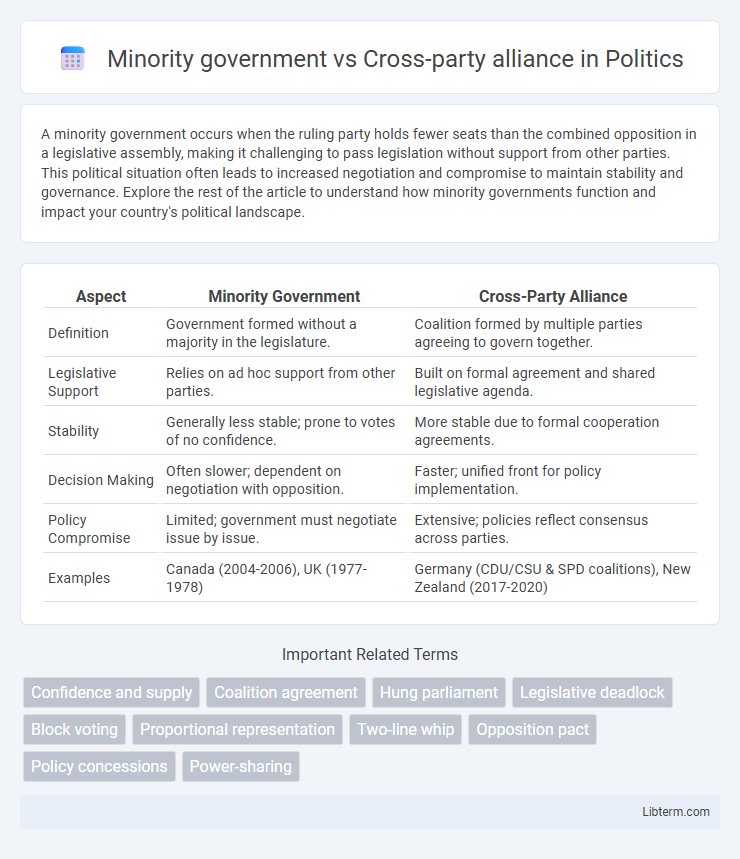A minority government occurs when the ruling party holds fewer seats than the combined opposition in a legislative assembly, making it challenging to pass legislation without support from other parties. This political situation often leads to increased negotiation and compromise to maintain stability and governance. Explore the rest of the article to understand how minority governments function and impact your country's political landscape.
Table of Comparison
| Aspect | Minority Government | Cross-Party Alliance |
|---|---|---|
| Definition | Government formed without a majority in the legislature. | Coalition formed by multiple parties agreeing to govern together. |
| Legislative Support | Relies on ad hoc support from other parties. | Built on formal agreement and shared legislative agenda. |
| Stability | Generally less stable; prone to votes of no confidence. | More stable due to formal cooperation agreements. |
| Decision Making | Often slower; dependent on negotiation with opposition. | Faster; unified front for policy implementation. |
| Policy Compromise | Limited; government must negotiate issue by issue. | Extensive; policies reflect consensus across parties. |
| Examples | Canada (2004-2006), UK (1977-1978) | Germany (CDU/CSU & SPD coalitions), New Zealand (2017-2020) |
Introduction to Minority Governments and Cross-party Alliances
Minority governments occur when a ruling party holds fewer than half the legislative seats, relying on support from other parties to pass legislation. Cross-party alliances involve cooperation between multiple political parties to form a majority, enabling more stable governance. Understanding these structures is essential for analyzing coalition dynamics and legislative decision-making in parliamentary systems.
Defining Minority Governments
Minority governments occur when a political party holds fewer seats than the opposition combined, lacking an outright majority in the legislature. Such governments rely on support from other parties or independent members to pass legislation, often leading to fragile stability. This contrasts with cross-party alliances, where multiple parties formally collaborate to create a majority government, sharing power and policy goals.
Understanding Cross-party Alliances
Cross-party alliances involve multiple political parties collaborating to form a majority, often to achieve common policy goals or stabilize governance, contrasting with minority governments that operate without majority support. These alliances enhance legislative effectiveness by pooling diverse parliamentary seats and forging consensus among varied party ideologies. Understanding cross-party alliances is crucial for analyzing coalition dynamics and their impact on political stability and decision-making processes.
Formation Process: Minority Government vs Cross-party Alliance
The formation process of a minority government occurs when a single party forms the government without securing an absolute majority in the legislature, relying on issue-based support from other parties to pass legislation. In contrast, a cross-party alliance is established through formal agreements between multiple political parties to collaboratively form a majority coalition, often negotiating shared policy platforms and leadership roles. Minority governments tend to emerge from election results with fragmented vote distributions, whereas cross-party alliances require proactive coalition negotiations to ensure legislative stability.
Stability and Longevity Comparison
Minority governments often face challenges in maintaining stability due to reliance on shifting support from opposition parties, resulting in shorter lifespans and frequent policy uncertainties. Cross-party alliances typically enhance government stability by fostering cooperative decision-making among coalition members, which extends the government's longevity and provides a more predictable legislative agenda. Empirical data from parliamentary systems show that cross-party alliances consistently outperform minority governments in durability and effective governance.
Policy-making Impact and Legislative Efficiency
Minority governments often face challenges in passing legislation due to the lack of a clear majority, leading to increased negotiation and compromise with opposition parties, which can result in slower policy-making but sometimes more moderate outcomes. Cross-party alliances enhance legislative efficiency by pooling support across political lines, facilitating smoother policy approval while promoting broader consensus and stability. However, minority governments may struggle with inconsistent support, whereas cross-party alliances can maintain sustained cooperation for complex policy agendas.
Negotiation Challenges and Power Dynamics
Minority governments often face intense negotiation challenges due to their reliance on support from multiple opposition parties, leading to unstable power dynamics and frequent policy compromises. Cross-party alliances involve complex bargaining processes to balance diverse interests, which can either stabilize governance through shared power or create friction if consensus is difficult to achieve. The power dynamics in minority governments tend to be fluid and dependent on constant negotiation, whereas cross-party alliances may institutionalize power-sharing but require ongoing cooperation to maintain effectiveness.
Historical Examples and Case Studies
The 2017 UK general election resulted in a minority government led by Theresa May's Conservative Party, relying on a confidence-and-supply deal with the Democratic Unionist Party to maintain power. In contrast, the 2010 UK coalition government between the Conservative Party and Liberal Democrats exemplifies a cross-party alliance forming a stable majority. Historical case studies such as Germany's Bundestag often demonstrate grand coalitions between major parties to avoid minority status and ensure legislative functionality.
Advantages and Disadvantages of Each Model
Minority governments offer the advantage of greater flexibility and potential for issue-based collaboration but often face instability and difficulty passing legislation due to lack of majority support. Cross-party alliances provide more stable governance and a broader consensus, enhancing policy durability, yet they may require significant compromises and slower decision-making processes. Both models balance representation and efficiency differently, impacting policy implementation and political coherence.
Implications for Democratic Governance
Minority governments often face challenges in decision-making and policy implementation due to their reliance on external support, which can lead to political instability and frequent negotiations. Cross-party alliances, formed through formal agreements between different political parties, tend to foster greater stability and collaborative governance, enhancing policy continuity and democratic accountability. Both structures impact democratic governance by influencing legislative efficiency, public trust, and the balance of power within parliamentary systems.
Minority government Infographic

 libterm.com
libterm.com